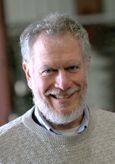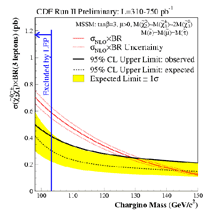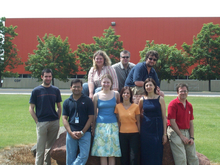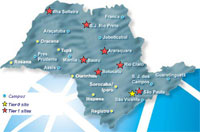 | Thursday, June 29, 2006 |
|
Thursday, June 29
Friday, June 30 Click here for a full calendar with links to additional information. |
|
Extended Forecast |
Secon Level 3 |
|
Thursday, June 29 -Minnesota Wild Rice w/Chicken -Tuna Melt on Nine Grain -BBQ Ribs -Chicken Casserole -Buffalo Chicken Wrap -Assorted Slice Pizza -Carved Turkey |
|
Thursday, June 29
Wednesday, July 5
Chez Leon Menu |
| Fermilab Today is online at: http://www.fnal.gov/today/ Send comments and suggestions to today@fnal.gov Fermilab Today archive Hurricane Relief Page Fermilab Today PDF Version Fermilab Result of the Week archive Fermilab Safety Tip of the Week archive Linear Collider News archive Fermilab Today classifieds Subscribe/Unsubscribe to |
| ||
|
SLAC physicist Marc Ross has been named head of Fermilab's Technical Division, beginning in the fall of 2006.
Ross has played an integral part in SLAC's accelerator activities
"Congratulations, Marc, from everyone at SLAC," said SLAC Director Jonathan Dorfan. "You have made a tremendous contribution to the lab's accelerator program and we will miss you enormously. We look forward to working right alongside you as you apply your impressive skills and deep technical knowledge to strengthen working relationships between SLAC and Fermilab and drive the ILC project forward." Fermilab Director Pier Oddone welcomed Ross's appointment. "I am delighted that Marc is joining Fermilab and will play a key role in developing the technology for the ILC," Oddone said. "He brings enormous energy and technical talent. He is recognized world-wide for the strong collaborations that he has developed in the ILC community. He will help us build an even stronger collaboration between the groups at Fermilab and SLAC and, extending well beyond that, to the world-wide collaboration." Ross looks forward to building a strong bridge between SLAC and Fermilab and the other laboratories and universities working on the ILC.
"Scientific collaboration among labs and universities must be a grassroots process," Ross said. "Global connections begin at home. It is in this spirit that I have accepted the position at Fermilab. We will develop the strong, unified national and international organization required to build the International Linear Collider."
|
| |||
|
Yesterday's edition of The Beacon News reported that West Nile-infected mosquitoes were recovered from a pool at Fermilab. The use of the word "pool" has caused understandable concern and confusion. Just to clarify: From a total 186 samples taken at Fermilab, the Kane County Health Department found one West Nile-infected mosquito sample. The infected sample was not pulled from the swimming pool; it was pulled from a west-side pond.
Test samples were taken from the east and west sides of Fermilab on June 8, June 15 and June 22. The latest west-side sample revealed the West Nile virus. This is not a new phenomenon at Fermilab. Last summer's tests revealed a total of 5 infected sample batches onsite, and samples from the summer of 2004 revealed 2 infected samples. Infected mosquitoes have also been found in other test areas of Kane and DuPage counties this summer, such as West Dundee, West Chicago, Elgin, Aurora and Naperville. According to The Beacon News, no birds have tested positive for the virus, and no human cases have been identified in Kane County this year. Fermilab Roads and Grounds' Mike Becker says the Kane County Health Department has been testing for West Nile at Fermilab for three years, and Fermilab participates in annual meetings with DuPage and Kane County Health Departments to discuss expectations for each mosquito season. "I have spoken with both Fred Carlson (Kane County Health Department) and Tad Koeune (DuPage County Health Department) this morning and neither is surprised that we have turned up a positive," said Becker. "I described our larviciding and adulticiding program to them again, as I had done earlier in the year and they had no additional suggestions. We will continue to adjust our program based on their recommendations." Fermilab's Roads and Grounds crew places cork-sized insecticide briquettes in standing water to discourage breeding, and sprays the adults a couple times a week--targeting populated areas like the Village and DZero.
80 percent of people infected with West Nile have no symptoms; a smaller percentage experience flu-like symptoms such as nausea and vomiting. Only .7 percent experience more severe version of the sickness, occasionally leading to coma and in rare cases death. You can read more about West Nile in last week's safety tip.
|
| |
| West Chicago is a candidate for a new bus service initiative, which could include a connection from the West Chicago Metra Station to Fermilab. Please take a few minutes to view the proposed West Chicago service area and to submit your comments to the DuPage County planners via the comment form by June 30. |
|
The Economist, June 22, 2006: To catch a gravitational wave: Physicists hope to find a new astronomy and test some wacky ideas SCIENTISTS trying to detect gravitational waves-ripples in the fabric of space-time-are a reticent lot. Understandably so: in the late 1960s Joseph Weber, a pioneer of the field, declared that he had found them when he had not, and mouths have been kept firmly shut ever since. Nearly 40 years on, researchers around the world are still straining to see gravitational waves, so far without success. This week scientists met to discuss plans for a more sensitive detector that could be built in space. Read More |
| CDF turns to the Dark Side |
|
Ordinary matter and anti-matter, described to an outstanding
accuracy by a theory called the Standard Model, make up only 5 percent
of the energy in the Universe. A variety of cosmological data
suggests that 25 percent of what is actually out there is unknown ``dark matter," unseen material that may be
relics from particles present in the early universe.
Currently the best theory to explain the origin of dark matter is Supersymmetry (SUSY), which predicts the existence of a "superpartner" for each Standard Model particle. The lightest superpartner of the neutral bosons, called the "neutralino," is an excellent candidate for this elusive form of matter. Being able to observe the SUSY particles would be crucial for a deep understanding of the universe. Superparticles could be generated in proton-antiproton collisions at the Tevatron, and detected through their decay into Standard Model particles and "missing energy" from the neutralino. At CDF we hunt for the supersymmetric partners of the bosons, the charginos and the neutralinos, utilizing a spectacular signature with multi-leptons and missing energy. Since we expect just a handful of Supersymmetry events among billions of Standard Model ones, we maximize our chances by looking for events with leptons of different flavors in different combinations. We observe 11 events in up to 750 pb-1 of data, which is consistent with the expectations from the Standard Model, but could also be a hint for SUSY. Using these events, we constrain the chargino to be 130 times heavier than the proton(~ 1 GeV/c2). With the full luminosity expected from the Tevatron by 2009 we could probe chargino masses up to 250 GeV/c2, the region favored by Standard Model precision measurements. The Standard Model leads over SUSY so far but as soccer fans know: the ball is round and the game lasts 8 fb-1. |
| Result of the Week Archive
|
São Paulo Seizes Grid Initiative
| |
|
Grids are about to take flight in the Brazilian state of São Paulo. São Paulo State University (UNESP) has just received funding for a computing grid infrastructure that will link many of its campuses, to the benefit of researchers across the state. GridUNESP will supply computing resources for researchers in physics, biology and bioinformatics, geosciences and engineering and many other disciplines.
"UNESP has several research areas of excellence that demand a great deal of computing power and large amounts of data," says project coordinator Sérgio Novaes. "I believe that GridUNESP will provide the necessary means to improve even more our performance in these areas."
|
|
June 27 - 28 - Two stores provided 19 hours and 4 minutes of luminosity - NuMI trips - Water in lower Linac - KRF2 problems - A2 LCW leak - MiniBooNE Horn trips
Read the Current Accelerator Update
|
|
Weekly Time Sheets Due Tomorrow Due to the upcoming July 4th holiday, weekly time sheets are due in payroll by 10:00 a.m. on Friday June 30.
Housing Assignments for Fall 2006 and Spring 2007 |




